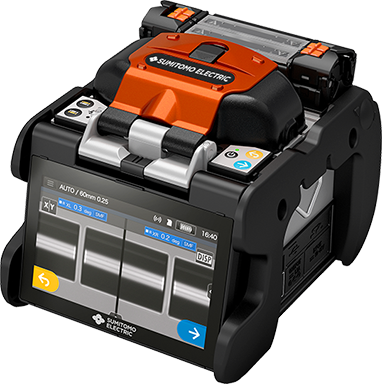Which Fusion Splicer is Best? Tumtec V9+ vs Fujikura 90S+ vs Sumitomo Q102-CA+

Buying a fusion splicer can be a large investment, likely costing tens of thousands of dollars. If you choose the wrong one, it can lead to many expensive mistakes, as each time you experience high splice loss, you have to rework it, which is costly in terms of time and additional materials. This article cuts through the marketing hype and presents real-life performance data from actual users of the Tumtec V9+, Fujikura 90S+, and the Sumitomo Q102-CA+. It takes into account performance data and other user experiences and provides you with a clear, fact-based decision-making tool so that you can make an informed decision on which fusion splicer to purchase that meets your operational environment, price point, and technical requirements, saving you time and money.
For more in-depth information, you should view from the fusion splice machine – FiberOptic.
Fusion Splicer Fundamentals: Core Alignment Technology Deep Dive for Beginners
Fusion splicing connects two optical fibers end-to-end to create a straight-through, low-loss connection. The alignment method used is critical to obtaining a quality splice. Two basic alignment techniques exist: core alignment and cladding, or “V-groove,” alignment.
· Core alignment fusion splicers align the microscopic cores of two fibers perfectly using high-resolution cameras and sophisticated algorithms. Think of this alignment as aligning the fiber’s tiny core under a microscope to perfectly match up. The 3D alignment assists in moving the cores in the horizontal, vertical, and down space until the cores perfectly match, accommodating any manufacturing offsets. This alignment only takes minutes, resulting in lower splice losses, which is critical for high-speed telecom backbones and hard-to-access networks.
· Cladding alignment uses the cladding, the outer reference point, for a rough alignment of the fiber’s cladding. It’s more like lining up the fiber’s external jackets, which takes less time and effort and costs considerably less money, sacrificing some precision of the splice. This cladding alignment works for less demanding applications where time and cost outweigh any low levels of signal loss.
· Core alignment fusion splicers tend to cost a little more money than cladding alignment splicers, but no other process provides the accuracy for long-lasting fiber optics. A basic understanding of these elements will help you understand that the precision of the technology makes a big difference in how long the network will last and its performance.
View Fusion Splicer – BYXGD for More Details
Tumtec V9+ vs Fujikura 90S+ vs Sumitomo Q102-CA+: Core Metrics Comparison
· Splicing Speed
o Tumtec V9+: Around 7-9 seconds in the field and complicated, outdoor condition settings.
o Fujikura 90S+: 7-8 seconds, the fastest in the industry for high-speed installations.
o Sumitomo Q102-CA+: 8-10 seconds, balancing speed with AI-enhanced high-precision control.
· Heating Speed
o Tumtec V9+: Around 15 seconds with good heating stability and speed.
o Fujikura 90S+: 9 seconds, which heats up extremely fast, aiming to maximize overall productivity.
o Sumitomo Q102-CA+: Approximately 14 seconds with smart heating to reduce total energy consumption.
· Core Alignment Technology
o Tumtec V9+: DACAS digital core alignment system, providing accuracy and suitability for harsh conditions.
o Fujikura 90S+: Features a core alignment process assisted by an automatic wind protector to help reduce environmental interference.
o Sumitomo Q102-CA+: Features the NanoTune alignment assist algorithm, AI-assisted core alignment designed to reduce transportation and rework rates.
· Battery Life
o Tumtec V9+: About 280-300 splices per complete charge, ideal for long-term outdoor work.
o Fujikura 90S+: Roughly 300-350 splices per charge, ideal for long, continuous work in bulk for multi-splice installations.
o Sumitomo Q102-CA+: About 250-280 splices on a single charge, while utilizing intelligent power-saving modes as needed.
· Durability
o Tumtec V9+: IP52 rated dust and water-resistant, and a shockproof design suitable for rugged outdoor conditions.
o Fujikura 90S+: IP52 rated dust and water-resistant, built for more stability in different outdoor environments.
o Sumitomo Q102-CA+: Built for industrial-grade applications with a higher IP54 protection level, extending life exposure to dust and artificially harsh environments.
· User Interface and Features
o Tumtec V9+: An LCD with tactile buttons providing a more streamlined and realistic operating experience.
o Fujikura 90S+: High-resolution touchscreen with a fully automated and smooth operating interface.
o Sumitomo Q102-CA+: Has a touchscreen operating interface built in, can connect wirelessly, and provides alerts for maintenance schedules.
· Automated Operation & Arc Calibration
o Tumtec V9+: Semi-automated operation with very precise arc calibration, providing stable splices.
o Fujikura 90S+: Fully optional wind protector and fully automated arc calibration increase efficiency and consistency.
o Sumitomo Q102-CA+: Has AI-assisted adjustment to automatically adjust parameters to minimize rework.
· Typical Use Cases
o Tumtec V9+: Ideal for mid-scale projects in complex outdoor environments, and chosen by field engineers.
o Fujikura 90S+: A perfect fit for large FTTx deployments at rapid speed, allowing for high throughput and chosen by large carriers.
o Sumitomo Q102-CA+: Typically used in smart, networked scenarios emphasizing long-term operational maintenance and management, plugged into FTTx scenarios.
Tumtec V9+ Fusion Splicer: Performance, User Feedback & Best Fit
· The Tumtec V9+ features DACAS – Digital Analysis Core Alignment System technology, which uses six precision motors for accurate core alignment. This advanced system produces minimal splice loss, which is crucial for keeping the signal intact in fiber optic networks. The splicer also benefits from German CNC manufacturing techniques to create a more precise construction that enhances structural stabilization during operation. The sturdy design allows it to withstand harsh environmental conditions, such as dust, water exposure, and extreme temperatures, making it adaptable for outdoor deployments where conditions can be very challenging.
· The V9+ comes with a detachable 5200mAh battery capable of over 250 splicing and heating cycles. This provides convenience and dependability for long field deployments. Many users agree on the ruggedness and reliability of the V9+ when used under difficult conditions, which is further enhanced by its core alignment ability while performing outdoor fiber splicing. Some users did mention that the weight of the unit, approximately 2.2 kg with the battery included, can be a potential issue during longer periods of use. The V9+ also has a combination of a 5-inch color LCD touchscreen and tactile buttons for inputting different settings, which new owners may need time to get accustomed to fully using.
· Overall, the Tumtec V9+ is considered a durable fusion splicer that provides a balance between accuracy and practical endurance. The V9+’s cutting-edge core alignment technology continues to make it a cost-effective, all-purpose option for mid-scale projects and field engineers designed to operate in unpredictable environments.
· One-line summary: A cost-effective rugged all-rounder built for demanding outdoor and mid-scale projects.
Fujikura 90S+ Fusion Splicer: Speed, Automation & User Insights
· The Fujikura 90S+ is known for its ability to splice fibers quickly, splicing fibers in 7-9 seconds. The benefit of speed significantly enhances productivity when working on large-scale fiber-optic installations. One aspect of the Fujikura 90S+ is the integrated automated wind protector that helps secure the fibers being fused. The wind protector shields the fused fiber from the environment and contributes to the quality of the splice. Automated fiber discrimination technology is also employed to detect the fiber being spliced and automatically set the splicing parameters. The fiber splicer comes equipped with Bluetooth compatibility to transfer data via wireless transmission for seamless future cleaver tracking and maintenance tracking.
· Consumers of the 90S+ are happy with the splicer’s speed and its automation, as it limits human intervention and provides a productive workflow. Some technicians report that the 90S+’s battery is not as strong as its competitors when used in extended field jobs, which means additional planning for battery management is needed. Either way, the intuitiveness of the touchscreen and automated sheath clamps make this splicer easy to use in the field.
· As a high-demand/scale splicer, this fusion splicer is perfect for fiber work where speed and accuracy are important. Each of the technologies described above contributes to a low splice loss and less rework, which is expected in enterprise deployments that value speed and accuracy.
· One-line summary: Speed and accuracy in a fiber splicer for large-scale and high-demand enterprise deployments.
Sumitomo Q102-CA+ Fusion Splicer: AI-Driven Accuracy & Maintenance Benefits
· The Sumitomo Q102-CA+ takes fusion splicing to the next level with NanoTune AI technology that minimizes splice reworks by using intelligent parameters based on the current conditions of the fiber. The AI, with slight adjustments and enhanced accuracy, reduces the expensive errors that arise from improper preparation of the fiber. Another intelligent feature of the splicer is the SumiCloud, which uses wireless connectivity to sync data and warn of possible preventive maintenance. These features alone will assist operators in predicting consumable replacements and potential faults, which will decrease unexpected downtime, which can be very costly when it comes to maintenance.
· Users like the Q102-CA+ for the long-term cost-saving effects coupled with its reliability. They cite savings directly attributed to parts being repaired less often and consistently better splices. Some of the feedback mentions a higher buy-in price compared to other standard models; however, that is somewhat in line with expectations due to increased technology and operational efficiencies. The device also has a 5-inch bright touchscreen, ruggedized efficiency testing for dusty, wet, and shock environments, which is trustworthy in the “field.”
· This fusion splicer would best serve operators and the field network teams that place more value on maintenance, ROI, and operational intelligence, instead of just raw speed. It suits operators looking to start using AI tools to improve precision planning for the overall long-term reliability of the network.
· One-line summary: Intelligent AI-driven splicer optimized for operators prioritizing maintenance and ROI.
Which Fusion Splicer Should You Choose? Tailored Recommendations by User Profile
Selecting the appropriate fusion splicer truly is based on your operational needs, the scale or volume of your project, and your budget. Various models will work better in different environments and for differing user profiles, meaning there is no “one size fits all” approach. Below is a clear breakdown of categories to help align your selection with your application.
· Enterprise, large-scale installations → Fujikura 90S+
The Fujikura 90S+ is intended for high-volume splicing and is fast and automated. It is best for large-scale FTTx installations (home, smart building, business, etc.), data centers, and backbone networks. With an automated wind protector and advanced fiber-type identification, you can minimize splice loss when speed, accuracy, and throughput are the top priorities. This is ideal for teams that are focused on operational ROI and being able to control quality in a high-volume splicing environment.
· Mid-scale, outdoor, and weather-diverse environments → Tumtec V9+
Built and aligned for toughness and accurate core alignment technology, the Tumtec V9+ expands usability for the most challenging outdoor conditions. When you need long-lasting performance to accommodate a battery life of a workday or several days in the field, the V9+ allows for mid-scale FTTx deployments, while acclimating to various job sites with diverse conditions. This splicer presents a balance of durability and precision for end-users that desire adaptability to the environment, without sacrificing performance and quality.
· Maintenance & ROI focus → Sumitomo Q102-CA+
The Sumitomo Q102-CA+ is a splicer that is purposefully developed around a number of intelligent features (for example, NanoTune AI, wireless connectivity, and device support). SumiCloud is a more connected platform that allows for a more intelligent splicing process and focuses on minimizing rework, where “maintenance” or planning for use, and continued accuracy, is a factor. This is a smart investment for fiber optic operators who are focused on ROI (taking into consideration future operational cost savings, as well as immediately reducing rework and improving splice quality). This splicer, with industrial-grade durability, is ideally suited for environments where continued maintenance of the network while in service, and data management utilizing detailed sources of data, is a requirement.
This strategic approach will ensure you are satisfied and that your fusion splicer is aligned with your operational profile, providing the requisite amount of splicing speed, environmental adaptability, and maintenance. By identifying and understanding your core priority—whether it be volume, outdoor weatherized environments, or efficiency with respect to maintenance—you can invest wisely in a wide range of costs and possibilities to improve your fiber optic splicing out in the field.
User Interface and Accessories: Which Brand Excels in Usability?
Concerning usability, the user interface (UI) quality and accessory reliability factors actually matter in the field. That said, the Fujikura 90S+ sets itself apart with its touchscreen interactivity and menu logic that make navigation and movement more accessible for even an inexperienced user. Some technicians noted that changing from one setting to another is quick, and there is not usually any confusion, which means you can be less prone to making mistakes on projects where you may have high-volume splicing. While the Sumitomo Q102-CA+ has a nice design of UI, it has a simplified layout with clear graphical prompts. Many users also reported that this interface was less overstuffed with information and more straightforward for users to understand, especially from a routine maintenance perspective, putting it one step ahead of the game with day-to-day workflows for service projects.
The Tumtec V9+ has an LCD interface with physical buttons, which allows for a tactile feel for users who prefer the tactile interface, especially when working with gloves, or in a field setting. This decision took a little bit more time to acclimate to, especially for new users, but this is still a useful design choice for working outdoors in rough and rugged environments.
The lifespan of a cleaver blade, or lack thereof, is another area of consideration in the realm of accessories. Users who utilize a Fujikura generally have confidence in the longevity and ease of replacing the precision cleaver blades, allowing for minimal downtime. Similarly, the Sumitomo has a clever, multifunction fiber holder that allows for fast swaps and an optimal setup experience. In contrast, the Tumtec fiber holder certainly has its strengths but offers more of a robust fiber holder to stabilize a fiber during the splicing process.
In the end, the right UI design and longevity of accessories have the potential to impact not just comfort, but quality in splicing and efficiency in the field, which translates into a meaningful and reliable connection regardless of the project.
Ultimate Fusion Splicer Decision Tree to Empower Your Purchase
To start the process of selecting the right fusion splicer, you first need to clearly define your main priorities, which will either be speed, fusion splicer durability, and/or fusion splicer intelligent features (AI). This first step will focus the decision on what really matters in the context of your project, whether it’s speed of deployment, rugged field application, or intelligent AI-based maintenance.
Additionally, you should also have a realistic budget range in mind. Your financial range will narrow down your options further and create a balance between cost and features, avoiding overspending on unnecessary needs.
At the end of the process, you will match the prioritized needs and specified budget to the specific splicer model you feel fits the best:
· Choose the Fujikura 90S+ if your needs are speed, automation, and large-scale deployment.
· Choose the Tumtec V9+ if you prioritize durability and outdoor applications for smaller jobs.
· Select the Sumitomo Q102-CA+ if intelligent AI features and maintenance ROI are your top priorities.
The ultimate choice of the right fusion splicer depends on your operational profile. In other words, it depends on what your operational needs are when splicing fiber optic cables. Use this decision tree as your guide to understanding the fusion splicing landscape with confidence in selecting the right fusion splicer and the splicing process for fiber optics in general.





